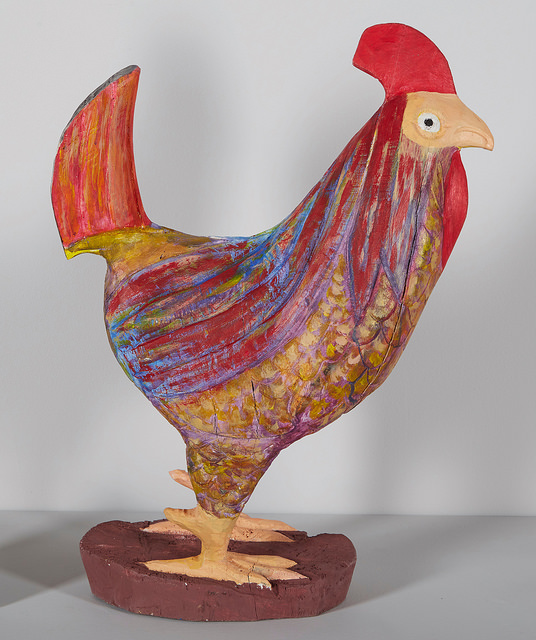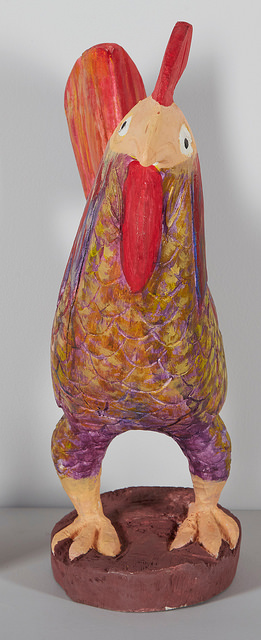At The Conservation Center, we have the distinct privilege of seeing a remarkable variety of artworks and heirlooms come through our doors. We also have the privilege of getting to learn a bit about varied passions of the many dedicated collectors that seek conservation, and what it is that makes each of their collections unique. One such collector is Norm Bobins, who has come to The Conservation Center over the years with pieces ranging from Meissen Monkey Band figures and a porcelain candelabrum, to lacquered objects, paintings, engravings, and photographs in need of conservation. Recently, Norm and his wife Virginia, who is his constant collaborator in both life and collecting, brought a wooden rooster figure with an interesting story to The Center for treatment. We knew that we had to learn more about Norm’s collecting history and the story behind this particular piece, so Heather Becker, The Center’s CEO, sat down with Norm to discuss his eclectic collection.
Norm revealed that he first discovered his passion for collecting as a young boy, when he began to amass stamps as a hobby. Later, Norm started to collect more seriously, focusing on his interest in English sporting prints. As his collection of prints grew and he became increasingly familiar with the medium, he became discouraged by the fact that many of the prints he saw on the market had been removed from damaged books. Believing that these collections should be kept intact and restored rather than being dismantled and sold individually, Norm shifted his collecting habits, and started to collect color plate books. Today, Norm and Virginia’s collection has grown and is comprised of a wide variety of artworks, including approximately one thousand color plate books, which are focused primarily on the subjects of costume, sporting, and travel.
Norm’s interest in travel is not only represented in his books of prints, but in other arenas of his collection as well. Norm and Virginia often acquire items at auction and are in touch with art dealers around the globe, but a significant portion of their collection is acquired during their world travels. Not only can these mementos from trips be seen throughout their home, they also fill Norm’s office.
Pieces collected during travel including a decorated wooden figure of a musician from Morocco, a mask purchased in South Africa, and a pair of paintings from Cuba can all be seen in Norm’s office. There are also a number of roosters on display, including the one recently treated at The Center.
Like many of the other rooster figures in Norm’s collection, the wooden figure by artist Roy Shippy was purchased in Jamaica and shipped back to Chicago to be displayed in Norm’s office. Given that Norm does so much of his collecting while he is traveling, shipping has become a major consideration for him. He explained that while he has a preferred international shipper that he trusts to transport his artworks home safely, with long-distance transportation of fragile items, unexpected issues can arise. The rooster came to The Center after small holes were drilled in the piece during an inspection by US Customs officers. Norm remarked that the officers wanted to be sure that it was “just the rooster” coming into the United States.
As an active member of The Center’s Advisory Board, and a devoted collector, Norm shares The Center’s passion for preserving artworks for generations to come, and dedication to honoring the artist’s intentions for each piece during every step of the conservation process. So when Norm discovered the damage to the rooster figure, he knew he could trust The Center to restore the piece.
The Center’s Objects Department began by cleaning the piece to remove the light layer of grime that covered its surface. They then worked to reattach sections that had become detached in transit, and to fill and level the holes that had been drilled in the piece. Shrinkage splits in the piece were then stabilized using appropriate conservation methods, though they were not filled completely, as they were determined to be a part of the artist’s intended rustic aesthetic for the piece. Finally, the repaired areas were colored to match the original coloring as best as possible.
All in all, Norm cites his collecting as both a fun and significant part of his life, noting that the three most important things to him are his relationship with his wife Virginia, his work, and his passion for collecting. We look forward to working with Norm on many more conservation projects as his fascinating collection continues to grow!





